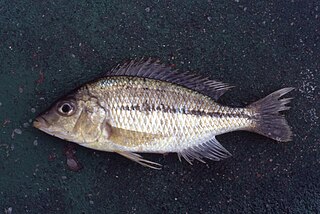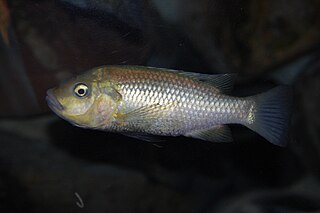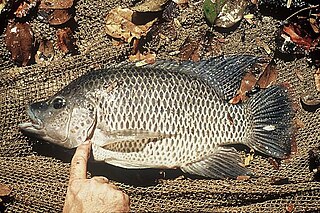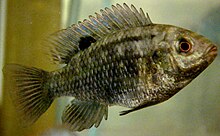
Copadichromis borleyi is a species of haplochromine cichlid fish endemic to Lake Malawi in East Africa. The species is popular in the fishkeeping hobby where it is frequently kept in aquariums. The species has numerous common names, including redfin hap and goldfin hap.
The lake salmon or mpasa is an African species of freshwater fish, endemic to Lake Malawi, in the family Cyprinidae found in Malawi, Mozambique, and Tanzania. Its natural habitats are rivers and freshwater lakes.

The brook stickleback is a small freshwater fish that is distributed across the US and Canada. It grows to a length of about 2 inches. It occupies the northern part of the eastern United States, as well as the southern half of Canada. Small populations are scattered throughout the Mississippi-Great Lakes basin extending to Colorado, New Mexico, Kentucky, Tennessee, etc., though some of these areas are not native to the species. This small fish inhabits clear, cool streams and lakes. They eat small invertebrates, algae, insect larvae, and occasionally their own eggs. They are also preyed upon by smallmouth bass and northern pike. Feedin time is usually dawn and sunset. The brook stickleback does have active competition mostly from minnows, but feeding times are different, along with diet. Spawning occurs in midsummer. Males secure a territory, build a nest, and mate with females. Males provide protection for the eggs, ward off predators, and usually die later in the season. This is considered an annual species. The nests are built out of aquatic grasses. Though the brook stickleback is not considered a threatened species, deforesting and changing waters are altering ecosystems of the species. Harvesting of trees around riparian environments is having a large effect of the stream ecosystem where the brook stickleback resides.

Chalinochromis brichardi is a species of fish in the family Cichlidae. It is found in Burundi, the Democratic Republic of the Congo, Tanzania, and Zambia. It is endemic to Lake Tanganyika. It builds a nest of rubble which is hidden by plants or algae, and its diet consists primarily of invertebrates. The specific name of this fish honours the fish dealer Pierre Brichard (1921-1990), who was the collector of the type.

The giant cichlid, also known as the emperor cichlid, is a species of fish in the family Cichlidae, endemic to Lake Tanganyika in Africa. It is the only member of its genus Boulengerochromis and tribe Boulengerochromini.

Buccochromis rhoadesii is a species of haplochromine cichlid. It is endemic to Lake Malawi, Lake Malombe and the upper Shire River in the countries of Malawi, Mozambique, and Tanzania.
Caprichromis liemi, the happy, is a species of haplochromine cichlid. It is endemic to the Lake Malawi region, being also found in Lake Malombe and the upper Shire River. It occurs over sandy substrates but it frequently remains in midwater. This species is a specialised predator, a paedophage, which steals the broods from mouthbrooding female cichlids by ramming the brooding female's head from below. Examination of their stomach contents resulted in the recovery of eggs, larvae and fry only. The juveniles act a cleaner fish, and so may the adults. The males build "sand castle" spawning sites. The specific name honours the ichthyologist Karel F. Liem (1935-2009), in recognition of his studies of cichlids.
Copadichromis geertsi is a species of haplochromine cichlid which is endemic to Lake Malawi.

Docimodus johnstoni is a species of haplochromine cichlid. It is known from Lake Malawi, Lake Malombe, and the upper Shire River in Malawi, Mozambique, and Tanzania. This species has unusual feeding habits: it is reported to feed on fins of clariid catfishes. The specific name honours the British explorer, botanist, linguist and Colonial administrator, Sir Henry Hamilton Johnston, who presented the type to the British Museum.

Limnotilapia dardennii, the latticed cichlid, is a species of cichlid endemic to Lake Tanganyika, where it prefers rocky areas near the coast. It may also be found in the aquarium trade. This species is currently the only known member of its genus.

The pearl of Likoma is a species of fish in the family Cichlidae endemic to Lake Malawi where it is native to rocky areas around Likoma Island and it has been introduced to Thumbi West Island. This species can reach a length of 10 centimetres (3.9 in) TL. It can also be found in the aquarium trade. Males are blue, while females are a greenish blue with rows of yellowish spots and shiny gills. They feed on crustaceans, insects, and larvae.

Protomelas kirkii is a species of cichlid endemic to Lake Malawi where it is most commonly found in areas vegetated with Vallisneria. This species can reach a length of 18 centimetres (7.1 in) TL. This species can also be found in the aquarium trade.

The redbreast tilapia is a species of fish in the family Cichlidae. It is found widely in the southern half of Africa. Its natural habitats are freshwater lakes and freshwater marshes. It is known as the redbreast kurper in South Africa.

The Cornish jack, Mormyrops anguilloides, is a species of weakly electric fish in the family Mormyridae, native to quiet waters in much of Sub-Saharan Africa. The largest species in its family, the Cornish jack is a nocturnal group hunter of smaller fishes, using electricity to locate its prey and communicate with other members of its group. It is a commercial game fish valued for its size and taste.
Synodontis dorsomaculatus is a species of upside-down catfish that is endemic to the Democratic Republic of the Congo where it occurs in the Lukusi and upper Lualaba Rivers and the Upemba lakes. It was first described by Max Poll in 1971. The original specimens were obtained in Kadia, Kisale, Katanga, in what is now the Democratic Republic of the Congo. The species name dorsomaculatus is derived from the word dorso, meaning "back", and the word maculatus, meaning "spotted", a reference to the dark round spots on the fish's back.

Sarotherodon linnellii, sometimes known as the unga, blackfin tilapia or blackbelly tilapia, is a cichlid endemic to Lake Barombi Mbo in western Cameroon. This species reaches a length of 18.5 centimetres (7.3 in) SL. It is critically endangered because of pollution and sedimentation due to human activities. It is potentially also threatened by large emissions of carbon dioxide (CO2) from the lake's bottom (compare Lake Nyos), although studies indicate that Barombo Mbo lacks excess amounts of this gas.

Deudorix lorisona, the coffee playboy, is a butterfly in the family Lycaenidae. It is found in Senegal, the Gambia, Guinea-Bissau, Guinea, Sierra Leone, Burkina Faso, Liberia, Ivory Coast, Ghana, Togo, Nigeria, Cameroon, Equatorial Guinea, São Tomé and Príncipe, Gabon, the Republic of the Congo, the Central African Republic, the Democratic Republic of the Congo, Sudan, Uganda, Ethiopia, Kenya, Burundi, Tanzania, Malawi, Zambia, Mozambique and Zimbabwe. The habitat consists of dense savanna and forests.

The redbelly tilapia, also known as the Zille's redbreast tilapia or St. Peter's fish, is a species of fish in the cichlid family. This fish is found widely in fresh and brackish waters in the northern half of Africa and the Middle East. Elsewhere in Africa, Asia, Australia and North America, it has been introduced as a food fish or as a control of aquatic vegetation. Where introduced, it sometimes becomes invasive, threatening the local ecology and species. The redbelly tilapia is an important food fish and sometimes aquacultured.

Orthopristis chrysoptera, the pigfish, hogfish, piggy perch, redmouth grunt or sailor's choice, is a species of marine ray-finned fish, a grunt belonging to the family Haemulidae. It is found in the western Atlantic Ocean. This name derives from the grunting or chattering noise these fish make by rubbing their pharyngeal teeth together.

Oreochromis mortimeri, the Kariba tilapia or kurper bream, is a species of cichlid, formerly classified as a Tilapiine cichlid but now placed in the genus Oreochromis, the type genus of the tribe Oreochromini of the subfamily Pseudocrenilabrinae. It is found in the rivers of south central Africa especially the middle Zambezi where it is endangered by the spread of invasive congener Oreochromis niloticus.


















